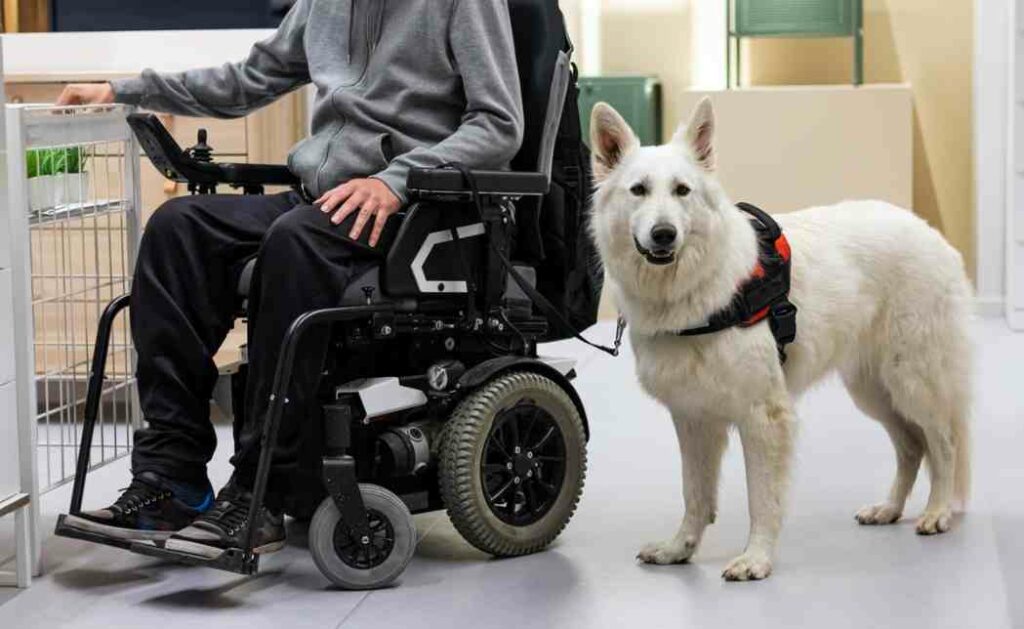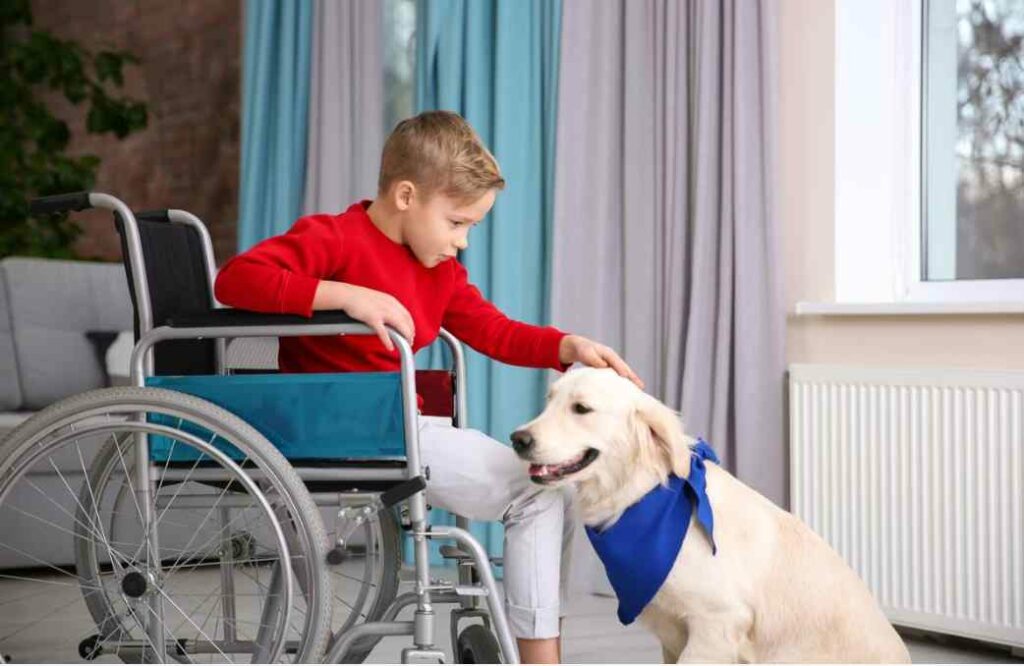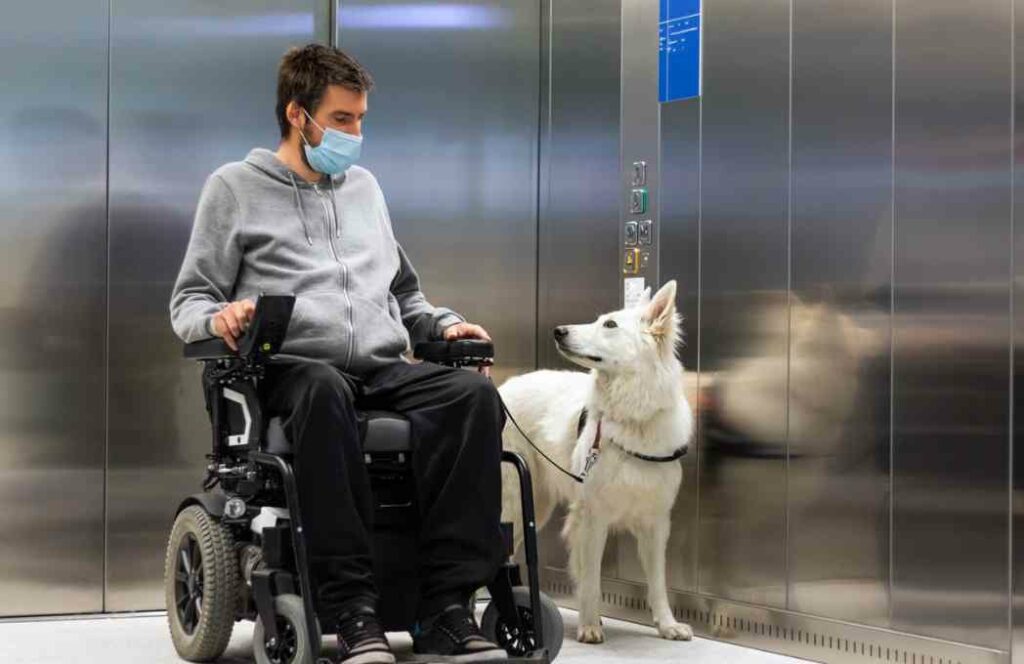10 Service Dog Breeds for Assisting People with Disabilities
61 million adults in the United States live with a disability (nearly 1 in 4 people). A service dog can provide life-changing help and companionship. Under the Americans with Disabilities Act (ADA), these hardworking pups have access rights to go anywhere their human partners need to be. But with so many breeds, which makes the best service dogs?
Temperament, intelligence, trainability, and a strong bond with their human partner are the most critical factors. A service dog can provide life-changing assistance and companionship with proper training and pairing.

Table of Contents
- What Exactly is a Service Dog?
- Successful Service Dog – The Top 10 Breeds
- The Main Types of Service Dogs and Their Specialized Tasks
- Mobility Assistance Dogs – Providing Independence and Support
- Guide Dogs – The Eyes for Those with Visual Impairments
- Hearing Dogs – The Ears for Those with Hearing Loss
- Psychiatric Service Dogs – Providing Emotional Support and Stability
- Autism Service Dogs – Supporting Children and Adults with Autism
- Seizure Alert and Response Dogs – Assistance for Epilepsy
- Sensory Signal Dogs – Support for Autism and Sensory Disorders
- Allergy Alert Dogs – Lifesavers for Severe Allergies
- Diabetic Alert Dogs – Detecting Dangerous Blood Sugar Changes
- FASD Service Dogs – Helping Children Overcome Prenatal Alcohol Exposure
- Conclusion
What Exactly is a Service Dog?
The Americans with Disabilities Act (ADA) defines a service animal as “individually trained to do work or perform tasks for a person with a disability.” Dogs are the most common service animal, though miniature horses also qualify.
Nearly 90.5 million dogs live in households as pets in the U.S. (as of 2021), and only a select few can call themselves legitimate service dogs.
For a dog to be considered a true service dog, it must go through specialized training to assist their disabled handler with specific needs related to their disability.
This can include:
- Guiding people who are blind or have low vision
- Alerting people who are deaf or hard of hearing
- Providing stability and support for mobility disabilities
- Reminding people to take medication
- Detecting impending seizures or low blood sugar
- Calming anxiety for those with PTSD or other psychiatric disabilities
Service dogs provide critical independence and companionship for over 3.6 million Americans living with disabilities. Their access rights are legally protected under the ADA in public places, housing, and transportation.
Proper service dog training and handler partnerships lead to life-changing assistance for people with disabilities. Man’s best friend brings help, comfort, and joy as only a well-trained service dog can.
Successful Service Dog – The Top 10 Breeds
Service dogs form life-changing partnerships with people living with disabilities. But what traits make for an ideal service dog?

The most important qualities are:
- Trainability – Ability to learn complex, specialized skills
- Focus – Able to work without distraction in public
- Calm temperament – Steady nerves in stressful situations
- Strong work ethic – Eager and energetic to complete tasks
- Bonding – Forms a close, working relationship with handler
With those key traits in mind, here are the top 10 service dog breeds
01. Labrador Retriever
Labrador dog is Eager to please, highly focused, and easy to train. Excellent for guiding, retrieval, and medical alerts.
02. Golden Retriever
Golden Retriever dog is Intelligent, calm, and friendly. Great for mobility, psychiatric, and medical assistance.
03. German Shepherd
German Shepherd dog is Protective, loyal, and fast learners. Ideal for guiding, psychiatric, and mobility work.
04. Poodle
Poodle dog is Brilliant, energetic, and hypoallergenic coats. They are often trained for psychiatric, seizure alert, and diabetic alerts.
05. Collie
Collie dog is Gentle, sensitive, and exceptionally bright. Well-suited for psychiatric and medical alert services.
06. Labradoodle
Gets the best traits from Poodles and Labradors. Trainable, friendly, with hypoallergenic coats.
07. Border Collie
Border Collie dog is Energetic, intensely focused, and highly trainable. Great for mobility and hearing assistance.
08. Corgi
Corgi dog is Smart, eager to please, and has an unmatched bonding ability. Excellent for medical alert and psychiatric work.
09. Pomeranian
Pomeranian dogs are Spirited and trainable small dogs. Ideal for medical alert and hearing assistance.
www.puppiesdiary.com
10. Greyhound
Greyhound dog is Calm, affectionate, and enjoy repetitive tasks. Top choice for mobility and balance assistance.
With proper training, most breeds can make terrific service dogs. But these 10 stand out for trainability, focus, and strong work drive. Matching the right dog with an individual’s needs is key for a successful service dog partnership.
The Main Types of Service Dogs and Their Specialized Tasks

Service dogs are paired with individuals to perform specialized work related to their disability.
The most well-known type is:
- Guide Dogs – Help blind or visually impaired handlers safely navigate environments. They are trained in intelligent disobedience to avoid dangerous situations. There are around 10,000 working guide dogs in the U.S.
However, service dogs assist people with all kinds of disabilities:
- Hearing Dogs – Alert deaf and hard-of-hearing individuals to essential sounds like alarms, knocks, phones ringing, and more. There are over 1,000 hearing dogs across America.
- Mobility Assistance Dogs – Provide stability, retrieve items, open doors, turn lights on/off, and other tasks for people with motor impairments.
- Medical Alert Dogs – Detect blood sugar, heart rate, breathing, or scent changes that can signify an impending medical crisis. They are often paired with people who have diabetes, seizures, or PTSD.
- Psychiatric Service Dogs – Help people with mental illnesses manage anxiety, remind them to take medication, provide comfort during panic attacks, and ground dissociative episodes.
- Autism Assistance Dogs – Support autistic children by keeping them safe, calming meltdowns, and tethering them to prevent bolting.
No matter their specialty, service dogs become lifelines for people with disabilities – granting them independence, confidence, and, best of all, a loyal companion.
Mobility Assistance Dogs – Providing Independence and Support
Also called service dogs, brace/mobility support dogs (BMSD) assist people with mobility disabilities and impairments. Common causes include spinal cord injuries, brain injuries, multiple sclerosis, arthritis, and more.
These specially-trained dogs aid with daily tasks that are difficult or impossible for the handler to perform independently.
Some specific jobs mobility dogs can provide:
- Pulling manual wheelchairs or retrieving dropped items
- Opening and closing doors, drawers, and refrigerators
- Turning light switches on/off
- Pushing elevator and handicap-accessible door buttons
- Providing counterbalance support and stability
- Bracing to assist standing or transfers
Mobility service dogs are often large breed dogs, around 50-70 lbs, to perform these physically demanding tasks. Common breeds include Golden Retrievers, Labradors, German Shepherds, Great Danes, Bernese Mountain Dogs, and Rough Collies.
No matter their size or breed, mobility assistance dogs provide crucial independence, confidence, and companionship. They transform lives by enabling people with disabilities to navigate their world with pride and dignity. Approximately 15,000 mobility service dogs are partnered with Americans needing their support.
Guide Dogs – The Eyes for Those with Visual Impairments
Also referred to as seeing-eye dogs or visual assistance dogs, guide dogs support people who are blind or have significant visual impairments. They act as a trusted set of eyes for their handler.
The origins of guide dogs date back centuries, but the first schools began in Germany in 1916 to aid veterans blinded in WWI.
Training takes 14-18 months and costs $40,000-$60,000 per dog. Guide dogs learn to navigate all environments, from office buildings to public transit. They identify obstacles, stop at curbs, find doors/handles, provide directional guidance, and even press elevator buttons.
Importantly, guide dogs are also trained in “intelligent disobedience” – to disobey any commands that could lead their handler into danger, like walking into traffic.
Ideal guide dog breeds are intelligent, trainable, focused, and calm in any environment. Labradors, Golden Retrievers, German Shepherds, and Poodles are the most popular species. There are approximately 10,000 working guide dog teams in the U.S. today.
These extraordinary dogs provide life-changing mobility and independence to those without sight. They exemplify the immeasurable contributions service dogs offer to people with disabilities.
Hearing Dogs – The Ears for Those with Hearing Loss
Hearing dogs are a vital aid for deaf or severely hard of hearing. Through extensive training, these dogs alert their handlers to essential and ambient sounds that would otherwise go unnoticed.
When noises occur, like alarms, timers, crying babies, knocks at the door, or phones ringing, the hearing dog is trained to make physical contact and lead the person to the source of the sound. This provides critical awareness of events in their environment.
Breeds well-suited for hearing dog work are intelligent, quick to alert, and intently focused. The top species chosen are Labradors, Golden Retrievers, Poodles, Cocker Spaniels, and various small terriers.
Hearing dogs must also be calm in public settings and have moderate energy levels. There are approximately 1,000 certified hearing dog teams in the U.S.
These incredible dogs provide independence and companionship for those with significant hearing impairments. The human-canine bond exemplifies the mutually beneficial relationship between service dogs and their handlers.
Psychiatric Service Dogs – Providing Emotional Support and Stability
Psychiatric service dogs assist people with various mental health conditions such as PTSD, depression, anxiety, bipolar disorder, and panic attacks.
Their primary roles are to:
- Provide calming physical contact during emotional episodes or panic attacks
- Remind handlers to take prescribed medications
- Lead handlers out of a crowded space that induces anxiety or sensory overload
- Interrupt repetitive or harmful behaviors
- Wake handlers from nightmares or flashbacks
- Conduct room sweeps and turn on lights for those with PTSD
The most common recipients of psychiatric service dogs are military veterans and first responders coping with PTSD. However, others who have experienced trauma and those managing debilitating anxiety benefit immensely.
Breeds well-suited for this sensitive line of work are calm, comforting, highly trainable, and keenly in tune with their handler’s needs. Top species include Labs, Poodles, Schnauzers, Cavalier King Charles Spaniels, and Collies.
Approximately 20,000 psychiatric service dogs work in the United States. They provide critical emotional stability and enable people with mental health challenges to reintegrate into daily life.
Autism Service Dogs – Supporting Children and Adults with Autism

Autism service dogs are trained to assist people on the autism spectrum, including Asperger’s syndrome.
Their primary roles are to provide:
- Safety – Prevent wandering or bolting behaviors in children
- Calming – Alleviate anxiety and soothe meltdown episodes
- Socialization – Encourage social interaction and confidence
- Focus – Redirect repetitive or harmful behaviors
- Alerts – Notify parents/caregivers if the child is in danger
The sensitive and patient temperament of Labrador and Golden Retrievers makes them well-suited for this role. German Shepherds, Poodles, Collies, and Spaniels are also commonly selected.
Autism service dogs can be life-changing for both children and adults on the spectrum. Approximately 20,000 autism service dogs are partnered in the U.S.
They promote independence, social integration, self-regulation, and overall well-being. Autism service dogs exemplify the immeasurable ways dogs enrich the lives of people with disabilities.
Seizure Alert and Response Dogs – Assistance for Epilepsy
Seizure alert and response dogs provide vital assistance to those living with epilepsy and seizure disorders. While the ability to detect oncoming seizures is debated, they undoubtedly serve several lifesaving roles:
- Retrieving medicines or activating an alarm during a seizure
- Moving the handler to a safe position if they collapse
- Using momentum to move the person’s body during convulsions
- Getting help from nearby people
- Providing comfort and stability after a seizure
Larger, stronger breeds are best suited to assist and support during seizures physically. Common breeds are Labs, Golden Retrievers, German Shepherds, Great Danes, and Collies.
Approximately 20,000 seizure assistance dogs work in the U.S. They grant critical independence and security to those living with unpredictable and dangerous seizure conditions. Their services can mean the difference between life and death for some people with epilepsy.
Sensory Signal Dogs – Support for Autism and Sensory Disorders
Also known as social signal dogs, sensory signal dogs assist people with autism spectrum disorders and sensory processing disorders.
Their primary roles include:
- Interrupting repetitive behaviors like hand flapping, rocking, or spinning
- Preventing self-injurious behaviors like head-hitting or skin-picking
- Providing calming sensory input like deep pressure therapy
- Alerting handlers to noises or prompts, they may not notice
This specialized training helps people with sensory regulation challenges lead more independent and socially integrated lives. Labrador Retrievers, Golden Retrievers, and mixed-breed dogs are well-suited for sensory signal work.
Approximately 5,000 sensory signal dogs are partnered with children and adults in the U.S. They help handlers navigate overwhelming environments and regain focus during sensory overload episodes. Their services are invaluable for promoting self-regulation skills.
Allergy Alert Dogs – Lifesavers for Severe Allergies
Allergy alert dogs (AADs) are lifesavers for people with severe, life-threatening allergies. Through extensive training, they learn to detect minute traces of allergens like peanuts, wheat, bees, shellfish, etc.
When an allergen is present, the AAD is trained to alert the handler before exposure. This prevents the severe, potentially fatal reactions associated with anaphylaxis.
Any breed can excel at this role if they have keen scent-detection abilities. Popular choices include Labradors, Golden Retrievers, German Shepherds, and terrier breeds.
Approximately 100-200 working AADs in the U.S. provide children and adults with severe allergies the freedom to navigate the world with significantly less fear and limitations. Their allergen detection truly saves lives.
Diabetic Alert Dogs – Detecting Dangerous Blood Sugar Changes
Diabetic alert dogs (DADs) are trained to detect dangerous fluctuations in the blood sugar levels of people with diabetes. Using their exceptional scenting ability, DADs can identify when their handler’s blood glucose is spiking or dropping to unsafe levels.
When they detect high or low blood sugar, the dog is trained to alert the person through signals like pawing, nudging, or barking. This allows the handler to test their levels and take corrective insulin or sugar as needed before serious complications arise.
Labrador and Golden Retrievers are often selected, but other scent-driven breeds like German Shepherds and Poodles also make excellent DADs. There are approximately 20,000 working diabetic alert dogs in the U.S.
By identifying blood sugar emergencies before they become critical, diabetic alert dogs grant crucial independence and peace of mind to those with diabetes. Their lifesaving scenting skills are invaluable.
FASD Service Dogs – Helping Children Overcome Prenatal Alcohol Exposure
Fetal alcohol spectrum disorder (FASD) service dogs support children exposed to alcohol in the womb, causing lifelong physical and cognitive impairments.
FASD can result in learning disabilities, speech issues, hyperactivity, poor memory, impaired motor skills, and problematic behaviors.
FASD service dogs are trained to provide several forms of assistance:
- Calming and comforting children during emotional outbursts
- Preventing repetitive, obsessive, or self-harming behaviors
- Keeping children from danger through tethering
- Encouraging positive social interactions
- Improving focus during learning activities
Labrador Retrievers, Golden Retrievers, and Labradoodle mixes are top choices due to their calm and patient temperaments. Approximately 500 FASD service dogs are working in the U.S.
They help these vulnerable children navigate daily life and reach their full potential despite the challenges caused by prenatal alcohol damage. Their support makes lifelong impacts.
Conclusion
The Life-Changing Power of Service Dogs
Service dogs transform lives by providing critical assistance that enables greater independence and safety for people with disabilities. This overview highlights that they serve various individual needs through extensive, specialized training.
Whether guiding the blind, alerting the deaf, providing mobility support, detecting seizures, or comforting PTSD – service dogs exemplify the human-canine bond at its most powerful and meaningful.
The commitment is significant, but life with a well-matched service dog is undoubtedly life-changing. Their impact provides immeasurable value to over half a million Americans.
If you have a service dog, we’d love to hear about your experience in the comments. What new insights did you gain for those considering getting a service dog? Please share your thoughts on these fantastic assistance dogs!



![Is An Australian Shepherd The Same As A Blue Heeler? [5 Hidden Facts] 7 Is An Australian Shepherd The Same As A Blue Heeler? [5 Hidden Facts]](https://www.puppiesdiary.com/wp-content/uploads/2023/02/Is-An-Australian-Shepherd-The-Same-As-A-Blue-Heeler-768x555.webp)


![Do People Give Pit Bulls Steroids? [Read Expert Advice] 10 Do People Give Pit Bulls Steroids? [Read Expert Advice]](https://www.puppiesdiary.com/wp-content/uploads/2023/02/Do-People-Give-Pit-Bulls-Steroids.webp)